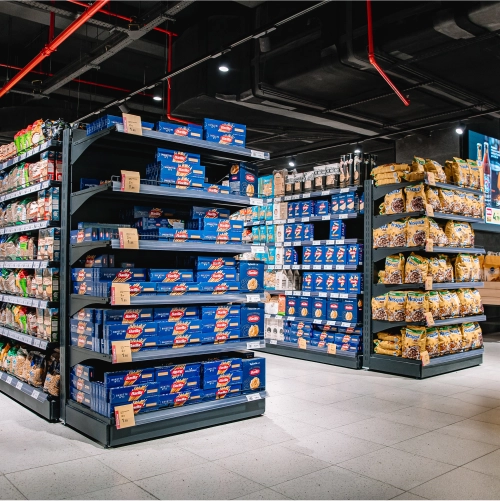Classification of retail shelving
- / Blog
- / Classification of retail shelving
Commercial shelving is equipment for storing and displaying goods in sales areas. They help to organize the space, present the goods in a favorable light and simplify the access of customers to the products.
Advantages of retail shelving
Shelving is in demand due to the following advantages:
- Space saving. Shelving allows you to place goods vertically and free up aisle space.
- Convenience for customers. Competent lay-out makes the goods available and visible.
- Flexibility of configuration. Most shelving has a modular design, which allows you to adapt them to different types of products and the size of the room.
- Durability. Metal shelving can withstand significant loads. Therefore, they are chosen for storing household appliances, building materials, heavy loose products (flour, sugar) or beverages.
- Aesthetics. Shelving looks neat and can be decorated in accordance with the design of the hall, creating an attractive showcase for products.
- Ease of assembly. They are easy to assemble, transport and modify. This is convenient for businesses with changing needs.
These advantages make shelving indispensable equipment for a supermarket, small store or any other retail space.
Classification by construction
Different types of retail shelving differ in terms of construction type and placement method. Each type solves certain problems and is suitable for specific shopping areas. By design, there are such types of shelving for the store:
- Wall-mounted - installed along the walls of the hall or internal dividers. They save space, as they use only one side for the display of goods. They are used in grocery stores, clothing stores and household appliances. The shelves are usually height adjustable. Therefore, the design can be adapted to different goods.
- Island - two-sided designs that are placed in the center of the hall. Thanks to access to the goods from both sides, they are suitable for a variety of trade formats and are used for the display of groceries, cosmetics or small electronics.
- End shelving - installed at the end of a row of island shelving or at the intersection of aisles. They complete the design and are often used for promotional goods or products that require special attention.
Types of retail shelving by purpose
By purpose, the following types of shelving are distinguished:
- 1. Bread - shelves are equipped at an angle for a better view of products, and also have divisions into sections for different types of baked goods. This design preserves the freshness of bread and guarantees convenience for customers. They are used in retail outlets of different formats - from small stores to supermarkets and bakeries.
- 2. Vegetable - have shelves with several levels of inclination, which simplifies access to products. They are made of materials that are resistant to moisture, reducing the risk of loss of quality of vegetables.
- 3. Book shelves - designed for easy visibility and access to printed products. The shelves are positioned so that every book is visible. They are used in stores and retail areas where an assortment of printed products are displayed.
- 4. Beverage shelving is a universal solution for placing both soft drinks and alcoholic products - from water and lemonades to elite wines and spirits.
This classification helps you select shelving that is suitable for the specific type of product and store objectives.
How to choose?
There are several aspects to consider when looking for retail shelving:
- Floor area. You need to assess the size of the hall and the height of the ceilings. Designs are selected depending on the layout and trading tasks: wall shelving, corner, island and end shelving can be used both in small stores and in spacious supermarkets.
- Type of goods and material. When choosing shelving, it is important to take into account the characteristics of products - dimensions, weight, shape and storage features. For different commodity groups appropriate materials are selected: for example, for heavy goods use durable metal structures, for vegetables - moisture-resistant and ventilated, and for light - it is possible to use wood, glass or plastic.
- Load capacity. It is necessary to take into account the load of different goods when choosing shelving. This is important for storing bulky or heavy goods.
- Design. It is important to think through the design of shelving in advance, taking into account the corporate style and interior of the salesroom. Neutral colors or branded elements will help to create an attractive showcase.
- Budget. It should be taken into account that quality metal shelving can be more expensive, but will last longer.
Before purchasing, you should consult with your supplier to clarify technical details and customization options.
Our company 4RM Systems offers trade shelving of our own production, adapted to the needs of different formats of trade. Trade shelving helps to organize storage and display of goods in any commercial premises. Their classification allows you to find a solution for convenience stores with limited space and gas stations, as well as for supermarkets and hypermarkets.
Contact us to learn more about 4RM manufacturing and find the equipment you are interested in:

Нужна консультация?
Отправьте заявку, и мы Вам перезвоним.











